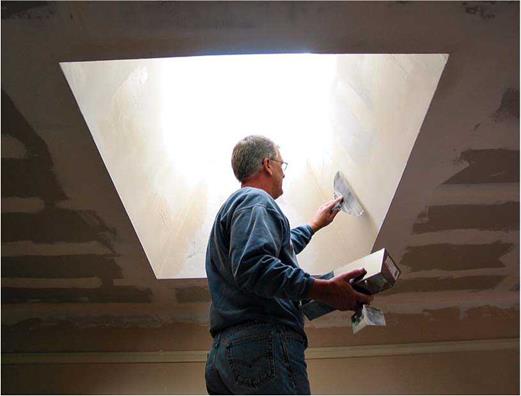Installing a Skylight
By letting in light, skylights can transform a room, making a bathroom seem larger, a kitchen warm and cheery, or a bedroom a place to watch the stars. And because of marked improvements in flashing and quality control, skylights can now
be installed without fear of leaks from outside or excessive heat loss from within.
Where you put the skylight is partly aesthetic and partly structural. If it’s a kitchen unit, catch the morning sun by facing it east. If placed in a hallway, even a small unit provides enough light to let you do without electric light during the day. In a bathroom, privacy is the main issue. Avoid skylights in south-facing roofs unless you’re designing for passive solar gain; such skylights can roast you in the summer. Similarly, skylights in west-facing roofs may create too much heat in the South and Southwest United States. Avoid skylights that straddle a ridge because they are difficult to flash and likely to leak.
Consider a number of things when buying a skylight, not least of which is the manufacturer. Although sizes have become pretty much standard, quality varies greatly—so ask local contractors or lumber suppliers which brands they prefer. Here are a few aspects to investigate:
► Do you want ventilating (openable) or fixed (closed) skylights? Skylights that open can vent excess heat. And turn-tilt models pivot so they’re easy to clean.
► Is it energy efficient? Most units come with doubled thermal-pane glass, but units should also have a thermal break to minimize loss by conduction. A metal frame that’s continuous (inside to out) will wick off a lot of indoor heat. A better bet is sealed wood.
► Does it have step-flashing along its sides (desirable for shingle roofing) or strip flashing, which must be caulked to keep water out? If the unit is wide (more than 32 in.), does the maker supply a cricket to deflect water around the skylight head?
Does the unit have tempered glass?
That’s an important consideration if a tree limb overhangs your roof. Your building code may require such glass.
If the unit will be installed beyond reach, how easy is it to open and close? Remote – controlled units with motors can be programmed to open at a given temperature, and shut when an electronic sensor detects rain, but such units are more expensive and more temperamental than manually operated ones.
Can you get units with screens, blinds, shades or polarizing tints? Low-Ecoatings selectively admit light while reflecting heat. Note: There are different coating types for cold and hot climates, so ask your supplier which is appropriate for your area.
|
Skylights dramatically change rooms. Because drywall joints and nail holes will be illuminated, too, apply joint compound generously and sand carefully. Heat buildup in the lightwell can cause compound to shrink, so you may need to apply an extra coat. |







Leave a reply